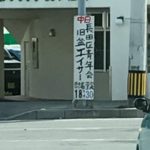If you are in Okinawa during Obon, then likely you will hear eisa drums in the distance. I previously wrote a tiny bit introducing about Okinawa’s bon dance, eisa エイサー, in another post. You can hear eisa pretty much year-round, and especially at summer matsuri (~July-October), but it is most important during Obon. Neighborhood Obon eisa can occur anytime in the 4 day interval from the first evening (unkeh ウンケー) usually until the day after last day (uukui ウークイ). The act of eisa parading around the neighborhood is called 道じゅねー “Michi Junee.”
So I know many people just keep their windows open and listen for the sounds of eisa, following it when they hear it. But, honestly there is a better way to find out when and where they will be performing near you… there are likely signs in your neighborhood, though if you don’t read Japanese, you might not realize that is what they are for. I have passed dozens upon dozens of simple painted wooden signs indicating when eisa will be performed for various neighborhoods, so just keep your eyes out; occasionally you will get some modernizing areas post it on the official village/town/city website or even on a Facebook page. So what do these signs looks like?
key words that you might see on signs:
旧盆 kyuubon お盆 obon エイサー eisa 盆踊り bon odori/bon dance ウンケー unkeh, the first day of obon 中日 nakanuhi, the 2nd day of obon ウークイ uukui, the 3rd day of obon 月 month 日 day 時 hour 場所 place/location 区 ward/neighborhood 公民館 public hall 広場 open space/wide space

